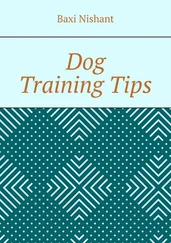In addition, some dogs, particularly those not accustomed to wearing a head collar, dislike wearing it and paw at it, try to rub it off or pull excessively. If your dog exhibits this behavior, the best strategy is to keep it moving until it learns to accept the collar. A good alternative is to have the dog sit by pulling up on the dog’s head.
Another disadvantage of the head collar is the reaction that many people have to it. Many people think that a head collar is a muzzle, and react to the dog as if it may bite. While this is not necessarily a defect of the head collar, many people do find it troublesome.
In conclusion, training with a head collar is much like training with a training collar or any other equipment. While the head collar can be an important and useful tool, it is important to use it appropriately, follow all package instructions, and to combine its use with solid training methods. The eventual goal of dog training with a head collar should be to have the dog behave as well with a regular collar as it does with the specialized head collar.
Dog training with a training collar or choke collar
The basic dog training collar goes by many names, including choke collar, choke chain, training collar, correction collar and slip collar. These training collars are among the most popular and most commonly used tools with both amateur and professional dog trainers.
While a training collar is an effective tool, like any tool it must be used properly in order to be effective for you and safe for the dog. Among the most important considerations when using a training collar are:
Ø How the collar fits the dog. It is essential that the training collar be properly fitted to the dog. A properly fitted training collar is easier to use and safer for the dog.
Ø Putting the training collar on properly. There is a right way and a wrong way to fit a training collar, and putting it on wrong will make it both ineffective and potentially dangerous.
Ø Using the collar properly. A training collar should be used as a sharp reminder to the dog, not as punishment. It is important that constant pressure be avoided when using a training collar.
Ø The weight of the chain and the size of the links on the training collar. It is important that the weight of the chain be appropriate to the size and weight of the dog.
Ø The placement of the collar on the dog. It is important to properly place the collar on the dog.
The importance of a properly fitted training collar
Determining if the training collar is the right size is relatively easy. The ideal size training collar should fit snugly, yet comfortably over the dog’s head. It is important that the training collar not fit too tightly, but it should not be too loose either. A training collar that is too tight will be too hard to put on and off. On the other hand, a training collar that is too loose can accidentally fall off of the dog’s head when it lowers its head.
It is also important to know that a training collar that is too long for the dog requires a great deal of finesse to use properly. A collar that is too long can still be used, but it will require more skill on the part of the handler.
Properly sizing and measure the dog for a training collar
It is best to measure the dog’s neck with a tape measure, then add 2 to 3 inches to that measurement. So if your dog has a neck 12” in diameter, you would want to buy a training collar that is 14” in length. Chain slip collars are generally sized in two inch increments.
Fitting the collar properly
When fitting a training collar, the part of the chain which is connected to the leash should be on the top of the dog’s neck. With this type of arrangement, the collar releases the instant the leash is loosened. Training collars work by making the collar tight and loose in a fast manner. Tightening the collar is the first part of the correction, and making it loose is the second part of the correction.
If the part of the training collar that is attached to the leash is not on the top of the dog’s neck, the collar can still be made tight, but it will not release back to a loose state easily. This constant pressure on the dog’s neck initiates a counter response on the part of the animal, and the dog will quickly learn to pull and strain against the leash.
Finally, it is important to purchase a training collar that is well made and strong. Buying a high quality training collar, slip collar or choke collar is vital to the safety of yourself and your dog.
If the worst happens, and your dog’s training collar does break, it is important not to panic. Most dogs will be unaware that they have broken the collar, at least for a few minutes. In most cases, if you act as if the leash is still connected, you can probably get control of your dog back quickly.
When securing a loose dog, the best strategy is to make a quick slip lead by running the snap on the leash through its handle and then slipping it over the dog’s head. It may not be the best arrangement, but it will certainly do in a pinch.
Dog training – house training your dog
Dog training – dealing with house training issues
Training your puppy – eliminating biting behaviors
Bringing home a new puppy is always an exciting time. Introducing the new puppy to the family should be fun for both yourself and your puppy. One of the first challenges, however, to the excitement of the new puppy, is curbing inappropriate puppy behaviors.
Preventing biting and mouthing
Biting and mouthing is a common activity for many young puppies and dogs. Puppies naturally bite and mouth each other when playing with siblings, and they extend this behavior to their human companions. While other puppies have thick skin, however, humans do not, so it is important to teach your puppy what is appropriate, and what is not, when it comes to using those sharp teeth.
The first part of training the puppy is to inhibit the biting reflex. Biting might be cute and harmless with a 5 pound puppy, but it is neither cute nor harmless when that dog has grown to adulthood. Therefore, puppies should be taught to control their bit before they reach the age of four months. Puppies normally learn to inhibit their bite from their mothers and their littermates, but since they are taken away from their mothers so young, many never learn this important lesson. It is therefore up to the humans in the puppy’s life to teach this lesson.
One great way to inhibit the biting reflex is to allow the puppy to play and socialize with other puppies and socialized older dogs. Puppies love to tumble, roll and play with each other, and when puppies play they bite each other constantly. This is the best way for puppies to learn to control themselves when they bite. If one puppy becomes too rough when playing, the rest of the group will punish him for that inappropriate behavior. Through this type of socialization, the puppy will learn to control his biting reflex.
Proper socialization has other benefits as well, including teaching the dog to not be fearful of other dogs, and to work off their excess energy. Puppies that are allowed to play with other puppies learn important socialization skills generally learn to become better members of their human family. Puppies that get less socialization can be more destructive, more hyperactive and exhibit other problem behaviors.
In addition, lack of socialization in puppies often causes fearful and aggressive behaviors to develop. Dogs often react aggressively to new situations, especially if they are not properly socialized. In order for a dog to become a member of the community as well as the household, it should be socialized to other people, especially children. Dogs make a distinction between their owners and other people, and between children and adults. It is important, therefore, to introduce the puppy to both children and adults.
Читать дальше












